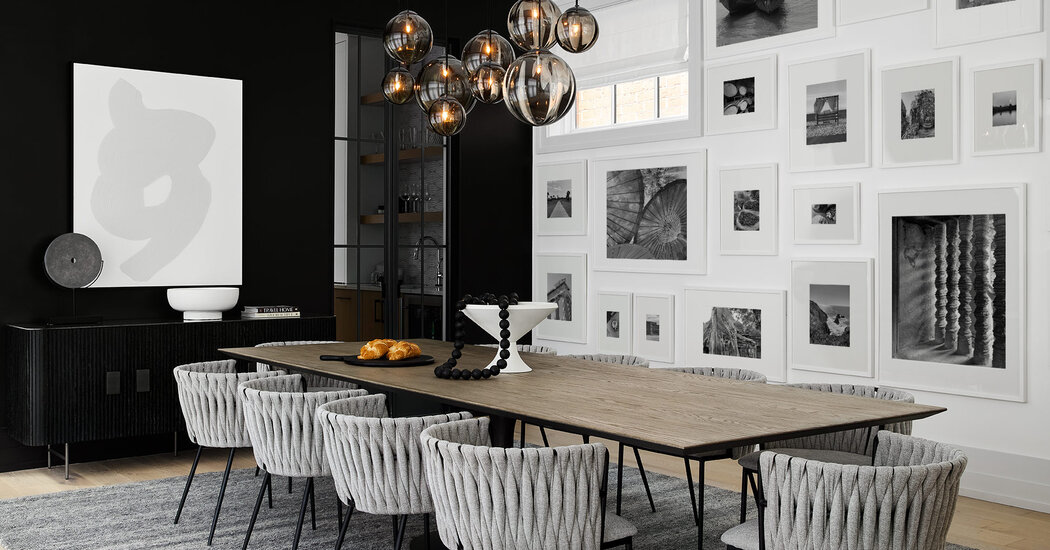Family photos, children’s artwork and other mementos can be an interior design challenge. We want to display them proudly, but kindergarten art projects and snapshots of relatives don’t always harmonize with the rest of the décor.
What to do? It all comes down to the presentation.
“Everything in a home should have meaning,” said Lauren Robbins, an interior designer in Augusta, Ga. “So taking pieces with history — whether it’s an heirloom piece of furniture or something as simple as children’s art — and incorporating them with a modern twist is really important.”
Displayed well, Ms. Robbins continued, that painting made in preschool can look as impressive as anything else in your home — and it can bring more joy.
She and other interior designers shared some advice.
Frame It
Putting family photos or children’s artwork in frames immediately elevates their appearance. If you plan to hang multiple pieces together, try mounting them in matching frames for visual unity, even if the photos or paintings don’t look that similar, said Caitlin Kah, an interior designer in Palm Beach, Fla.
The streamlined framing aesthetic is especially useful “when you’re dealing with a mix of black-and-white photos and color photos,” said Ms. Kah, who once used bamboo frames to display disparate family photos on a grasscloth-covered wall.
Black or white frames are a good, simple option, but colorful frames can also work well for hanging art by children, said Meg Lonergan, an interior designer in Houston.
“It’s fun to play up the childlike qualities of the art you’re framing,” said Ms. Lonergan, who has mounted paintings by her son in red frames. “Instead of trying to make it serious or formal feeling, lean into the nature of the work and frame it in something super eye-catching, cheerful and happy.”
Create a Gallery Wall
Once the pieces are framed, don’t just hang them in random spots. Create an organized gallery wall for a bigger statement.
Devon Wegman, the founder and design director of Devon Grace Interiors, a Chicago firm, is a fan of large-scale gallery walls with numerous family photos grouped together. “We usually try to create one moment where everything is compiled, like in an epic gallery wall,” Ms. Wegman said.
In the loft she shares with her husband and business partner, Michael Wegman, dozens of photos in black frames of various sizes run up an open staircase. To ensure the composition would have a sense of order — and that it would fill the entire wall — the couple modeled it with 3-D design software. For their clients, they have used the same process to create grids of evenly spaced family photos and free-form arrangements that look considered.
Ms. Kah has used Framebridge’s gallery wall service to achieve a similar effect with less effort: The company takes uploaded digital family photos and designs a gallery wall, then produces framed pieces along with a full-size template for mounting them on a wall.
Use a Picture Shelf
If you worry that a tightly designed gallery wall won’t allow you to add more over time — or if you simply don’t want to put so many holes in the wall — consider a shallow picture shelf or ledge, where framed pieces can be leaned against the wall.
“I love a picture ledge, because you can change things out really quickly, and it doesn’t have to be perfect,” said Ms. Kah, who installed picture shelves above the kitchen banquette in her home in Palm Beach, Fla. “You can layer things on top of each other. Compared to a gallery wall, it’s a little more low maintenance and can grow with your family.”
Beyond the kitchen, a long hallway is another good place for a picture shelf, Ms. Kah said. Ms. Wegman once used a picture shelf at a client’s home to hold family photos above the TV in the living room.
Run a Wire With Clips
If you want to change the art and photos on display frequently, or don’t want to go to the trouble of framing things, try a wire-based hanging system.
Ms. Lonergan and Ms. Wegman like stringing wires across walls with clips for suspending art. “That’s where things from my kids’ school would come home and get clipped up,” said Ms. Lonergan, who used a curtain wire from Ikea. “I would just cycle things out every couple of weeks. It’s a nice, informal way to display kids’ art that costs almost nothing.”
Install a Bulletin Board
A bulletin board, or pinboard, offers similar advantages. Ms. Robbins installed a fabric-covered one above a desk in the mudroom of her home in Georgia to hold her children’s artwork. But rather than choosing a plain fabric that would blend into the wall, she made it a feature by covering it in a patterned fabric printed with colorful illustrations.
“Because that whole wall was white, it really needed something to make that pinboard pop,” Ms. Robbins said. “It provides this fun background for the art we get from our children.”
The paintings and drawings on display change with the seasons, which helps keep things fresh. “That’s the beauty of a pinboard,” she said. “You can constantly change things out with whatever art you want to put on the wall.”
Make It the Center of Attention
If you’re more interested in celebrating one or two special pieces than displaying a large collection, there are other options.
Sarabeth Arima, an Atlanta-based artist, specializes in elevating family portraits by creating one-of-a-kind works around a favorite photograph. “It’s multimedia collage. I use paper, paint, pencil, you name it,” Ms. Arima said.
“It was something I started doing for friends, but then I had more and more people asking me to do it professionally,” she continued, noting that about a third of her commissions now come from interior designers. She described the pieces as “love letters to a family story.”
If you have a piece that already transcends the everyday, you could also make it the center of attention in a room. Ms. Robbins hung a painting by her three children above her living room sofa, and based the color scheme of the room around it.
The painting came together when her father, an abstract painter named Michael Patterson, put a canvas on the floor of his studio and invited the children to get messy. As they got to work, “I looked at my dad and said, ‘This is actually really good,’” Ms. Robbins said. When the adults provided some direction, it got even better.
Now framed and mounted above her sofa, “it’s such a conversation piece,” Ms. Robbins said. “People walk in and are like, ‘Oh, my gosh, where did you get that piece?’ And I’m like, ‘Oh, my kids did it.’”
For weekly email updates on residential real estate news, sign up here.
Sumber: www.nytimes.com












